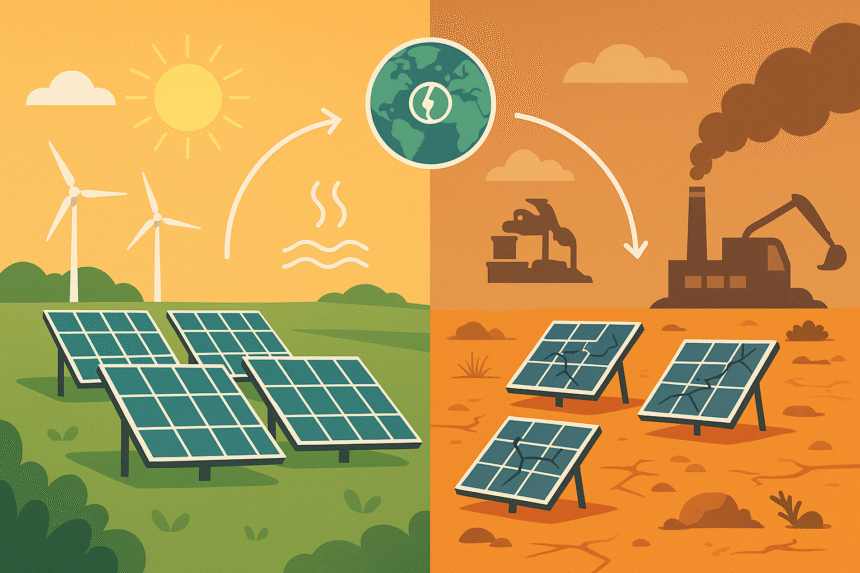
By ALLAH BAKHSH GULSHAN
GHAZI UNIVERSITY DERA GHAZI KHAN
In the recent days due to energy crises the tremendous use of solar panels as an alternate source of energy is increased across the country. For the daily life need use of solar is a dynamic component that shift towards the renewable energy and it is playing a substantial part in decreasing the greenhouse gas emanations and moderating the climatic change in the area. However, on other side it is essential to consider both the positive and negative impacts of solar panel installation on the climate change in the surroundings. A fundamental aspect to the transition towards renewable energy is the need of the time but the effects of installing solar panels on the climate change could be considered and need to be addressed according to the natural rule “survival of fitness”. for the life of animate on the part of biosphere. Solar panels are often hailed as a cornerstone of sustainable energy solutions, promising reduced greenhouse gas emissions and a cleaner alternative to fossil fuels.
However, a critical examination reveals a nuanced narrative with both benefits and challenges develop due to spreading the use of solar panels for fulfil the need of the energy. No doubt installing of solar panels has a generally positive effect on the climate by reducing greenhouse gas emissions and promoting cleaner energy source. Solar energy is a renewable resource that does not produce harmful pollutants like traditional fossil fuels thus helping to mitigate climate change. However, there are also some localized environmental impacts associated with the production and installation of solar panels that need to be considered and search out a possible solution of it. The power projects and solar energy technology do not produce airborne pollution and greenhouse gases during its operating time. But during using time of solar energy that could have a positive and indirect effects on the area of the surroundings, when solar energy itself decreases the use of other energy resources then effects on the environment is increased. where installation is done without proper planning and directions. However, the production of technology related to solar energy may have some environmental effects.
Materials like glass and metals are used in technologies of solar energy, that materials sometimes cause environmental issues. Various organizations and active research explorers have conducted Photovoltaic energy settlement analysis for system, which could produce energy equivalent the power used during its manufacturing time in some percent within one to four years. Most of the Photovoltaic (PV) systems have operating life upto thirty years or more. The harmful chemicals used during the engineering process of photovoltaic (PV) cells and panels must be carefully handled to avoid releasing them contaminations into the environment. Some types of technologies linked to PV cell use heavy metals and these types of cells and PV panels may require special handling, when they reach the end of their useful life. The potential use of some solar thermal systems releases a dangerous fluid during transfer of heat, and leaks of these materials could be harmful to the environment.
The environmental laws framed by the United States of America that have a function to regulate the use and disposal of perilous materials. The energy department of United States is helping in various types of efforts for addressing end-of-life issues related to solar energy technologies. The materials which are used in recovering and recycling mechanism for the manufacturing of PV cells and types and sizes of panels. Several other states have endorsed laws that encourage the recycling mechanism of PV panels. As with any type of power projects, large solar power schemes can affect the environment at or near their locations. The power projects which are installed on the clear land may have long-term effects on the local flora and fauna and their inclusive habitats.
However, the system of solar energy installation on open land has some patent agricultural value. So, the integrating solar system of energy on land farms may provide a variety of economic and environmental benefits for the growers. Some solar power projects may require water for cleaning the solar concentrators or for cooling turbine generators. Using large volumes of ground water or surface water for cleaning collectors in some arid locations may affect the ecosystems that depend on the water resources. In addition, the concentrated beam of sunlight, a solar power tower creates little bit radiations that could the kill birds and insects. In addition, solar panels generate electricity by harnessing sunlight, a renewable and abundant resource.
This process does not emit greenhouse gases during operation, making solar energy a vital tool in mitigating climate change. By displacing fossil fuel-based electricity generation, solar panels contribute to reducing overall emissions and promoting to clean air in better way. Despite the clear advantages, the installation of solar panels is not panels without challenges. The manufacturing of solar panels requires energy and resources, contributing to emissions and environmental impacts. Additionally, the disposal of solar panels at the end of their lifecycle poses potential environmental risks if not managed properly. The extraction of raw materials and the energy used during the manufacturing process of solar panels have some environmental consequences. Which are include: the developing recycling methods for solar panels is effectively critical to minimize the waste and environmental harms. Furthermore, to maximize the climate benefits of solar panels, it is essential for advancements in technology that could reduce the environmental footprint of solar panel production.
Moreover, its developing and implementing the effective recycling strategies for solar panels can mitigate end-of-life environmental impacts. Notwithstanding, the careful planning of solar farm locations and designs could minimize the impacts on local ecosystems and maximize the energy efficiency. There are various positive Impacts on climatic factors like the solar energy generates power without emanating harmful greenhouse gases and it is contributing in a critical way to moderate the environmental changes. Moreover, it is also reducing the carbon footprint.
It is the fact that by reducing the capacity of dependance on fossil fuels for electricity generation. In other side the solar energy is also contributing to clean the air and water continuously. Moreover, solar power decreases pollution levels compared to traditional energy sources like coal-fired power plants. Beside these there are some negative impacts on climate and environment which are potentially include: Firstly, the production of solar panels involves in extracting the raw materials and significant energy consumption, which are contributing to their environmental footprint. Secondly, solar farms are increasingly located in remote and risk-prone areas, making them vulnerable to natural catastrophes and extreme weather events like wildfires, windstorms, and hail. Thirdly, the pattern of solar radiations and its level of changes have more frequent production of heatwaves. This is all due to climate change which can affect the solar panel efficiency and productivity.
The mitigating negative impacts and enhancing sustainability is to incorporate resilient designs and conducting site-specific assessments can minimize risks associated with extreme weather events. In this sense the ongoing innovations in recycling solar panels, using sustainable materials, and improving energy-efficient manufacturing processes aim to reduce the environmental impact of solar energy. The proper placement and angling of solar panels can maximize efficiency and reduce environmental impacts as well. The concluding remarks regarding the installation of solar panels has both positive and negative effects on the climate.
While solar energy significantly reduces greenhouse gas emissions and promotes cleaner air and water, the manufacturing process and vulnerability to extreme weather events must be considered. By acknowledging these factors and implementing strategies to mitigate negative impacts, solar energy can play a more effective role in addressing climate change. Although, there are challenges associated with manufacturing and end-of-life management, ongoing innovations and strategic deployment can enhance the overall sustainability of solar energy. By critically examining both the benefits and challenges, we could work towards maximizing the positive impacts of solar panels on the climate.
PAKISTAN PAINDA BAD





